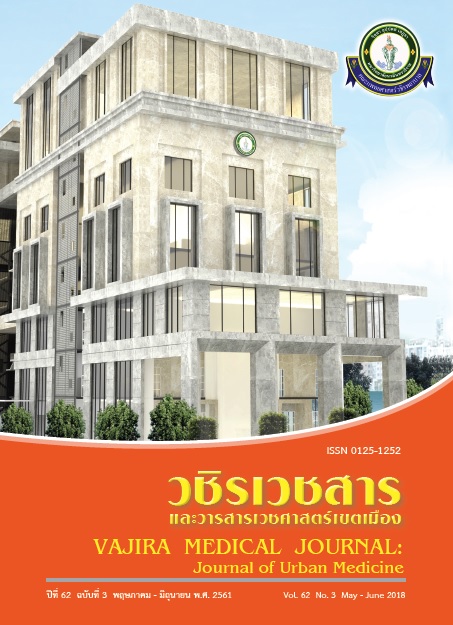Prevalence and Factors Associated with Medication Noncompliance in Patients with Noncommunicable Diseases at Specialty Clinics, Faculty of Medicine Vajira Hospital, Navamindradhiraj University
Main Article Content
Abstract
Objective: To study prevalence and factors associated with medication noncompliance in patients with noncommunicable diseases (NCDs) at Specialty Clinics, Faculty of Medicine Vajira Hospital. Navamindradhiraj University
Methods: This research design was a cross-sectional analytical study. The participants were 360 NCD patients who were treated at the Specialty Clinics, Vajira Hospital. Data were collected between June and August 2017. The instrument was a structured interview. Data were analyzed by using descriptive statistics, chi-squared test and multiple logistic regression analysis.
Results: The prevalence of medication noncompliance in patients with noncommunicable diseases was 40.8% (147 patients). The top 3 problems were underdosing medications (18.3%), taking medications irregularly (17.8%) and not taking medications (13.1%). The factors associated with medication noncompliance in NCD patients were, namely, the inconvenient dosing of medications (ORadj= 4.24, 95%CI = 1.74-10.36), insufficient prescription of medications (ORadj= 52.52, 95%CI = 4.52-610.73), not reading the labels before using medications (ORadj= 17.84, 95%CI=7.27-43.77) and inadequately knowledge about disease and drug regimens (ORadj= 95.21, 95%CI = 20.48- 442.62).
Conclusion: To reduce the level of medication noncompliance in patients with NCDs, healthcare providers should optimize the frequency and simplify the dosing regimens. Physicians should prescribe sufficient medications to cover the period between appointments. In addition, patients should receive adequate education about treatments and diseases, especially when regimens are changed. The other important issues are teaching patients how to cut tablets and use measuring devices. The importance of reading labels before using medications to prevent administration errors should be emphasized.
Downloads
Article Details
References
2. Thai Health Promotion Foundation (ThaiHealth). [internet]. 2017 Available from: http://www.thaihealth.or.th/microsite/categories/5/ncds.Retrieved February 13, 2017.
3. Bureau of Non-Communicable Disease Control Department, Ministry of Public Health. Annual Report 2015, Bangkok: Office of Printing Industry, The War Veterans Organization of Thailand Under Royal Patronage of His Majesty the King; 2016.
4. Cooney N. Literature Review: The current situation and care model of non-communicable diseases. Institute of Medical Research and Technology Assessment, Department of Medical Services. Ministry of Public Health; 2014.
5. Kongkaew C. Patients’ medication taking behaviours: Critiques of relevant terminologies. Thai Pharmac Health Sci J. 2011;6(4):299-302.
6. Sathapornnanon N. Medication non-adherence. Thai Bulletin of Pharmaceutical Sciences (CPE). Silpakorn University. 2555; 7.
7. Griffith S. A review of the factors associated with patient compliance and the taking of prescribed medicines. Br J Gen Pract. 1990; 40(332): 114–6.
8. Mongkolchaipak T, Pichayapaiboon S, Sangviroon A. Factors affecting medication adherence of diabetic patients at Police General Hospital. TJPP 2015; 7(1):47-59.
9. Chanachai C. Factors Affecting the medication compliance of elderly patients with chronic diseases at Namkleang Hospital, Namkleang District, Sisaket Province. Research Develop Health Syst J 2015; 8(2): 287-91.
10. Ploylearmsang C, Kerdchantuk P, SoonKang K, Worasin P, Kedhareon P. Drug-related problems and factors affecting on drug use problems in elderly of Banmakok, Kantharawichai, Maha Sarakham Province. MSU Journal 2013; 9: 803-812.
11. Chaichanawiroj U, Witthayachockkitikun N. Medication use behaviors among the older Thai adults. Complete Research Report. Faculty of Nursing: Naresuan University; 2557.
12. Leetaweesuk J, Makee P, Charachan P, Yana P, Jindawattanawong P, Thiratanyaboon L, et al. Drug use behaviors of elderly patients with chronic disease in Chiang-Tong community Rahang Sub-District, Muang-Tak District, Tak Province. Faculty of Medicine: Naresuan University; 2556.
13. Chisholm-Burns MA, Kim LJ, Spivey CA. et al. US pharmacists’ effect as team members on patient care: systematic review and meta-analyses. Med Care 2010 Oct; 48(10):923-33.
14. Hayes BD, Klein-Schwartz W, Barrueto F, Jr. Polypharmacy and the geriatric patient. Clin Geriatr Med 2007; 23(2):371-90.
15. Turner BJ, Hollenbeak C, Weiner MG, Tenhave T, Roberts C. Barriers to adherence and hypertension control in a racially diverse representative sample of elderly primary care patients. Pharmacoepidemiol Drug Safety. 2009;18(8):672-81.


